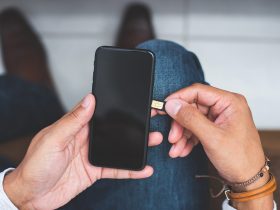It can be frustrating when life comes with so many rules, and it’s no different with our smartphones. Whether an iPhone or Android, they come “locked” by the manufacturer with certain software and security restrictions. If you remove these, you’re jailbreaking (or “rooting” for Android). Is it safe and what are the risks? Is it legal? If you’re the freedom-loving owner of an iOS device, read this jailbreaking guide before you bust your technology out of its confines—and always have comprehensive online protection in place, like Avira Mobile Security for iOS.
Available for PC, Mac, iOS, Android
What is jailbreaking?
Whether we like it or not, smartphones, tablets and other devices come with software restrictions that have been put in place by the manufacturer. Jailbreaking refers to the process of removing these so you can fully access the operating system of your iOS device. You’re then free to install custom firmware and third-party applications, modify settings, change your device’s appearance and make other tweaks to your heart’s content. These opportunities for customization may sound enticing, but you could be opening Pandora’s box along with your smartphone: Jailbreaking comes with increased security risks and can even void your warranty.
Before you shout “freedom!” and storm at your device’s operating system like a liberating superhero, remember these limitations are there for good reasons: mainly user safety and legal protections. Revenue also plays a role, understandably. Apple and Android earn money every time an app is purchased in the App Store and Google Play Store respectively.
Apple is famously protective of its ecosystem, so jailbreaking is usually associated with iOS devices, such as iPhones and iPads (and it’s what we’ll be focussing on in this guide). Similar processes do exist for other operating systems, but these tend to use different terminology and methods. Here’s a quick overview for your jailbreaking dictionary:
Rooting: This is jailbreaking for Android devices and grants users access to the operating system so they can modify system settings, install custom ROMs, and remove pre-installed apps. Although Android devices generally offer more freedom out-of-the-box than iOS, some Android fans want super-user capabilities.
Interop unlock: Remember phones from Microsoft? They’re no longer being manufactured, but some are still in use. Interop Unlock refers to the process of removing restrictions on Windows phones.
Sideloading: Amazon Fire OS powers devices like the Amazon Fire tablet. “Sideloading” is the process of installing third-party apps on Fire OS devices. It’s not considered as invasive as rooting or jailbreaking.
If jailbreaking, or any of the above, sound too illegal for you (more on this later), you might prefer the technical and more noble-sounding definition of “privilege escalation”. Ultimately, you’re granting yourself a higher level of access by slipping through a side door.
Is jailbreaking the same as unlocking a phone?
There is some overlap and one big difference! Both are ways of bypassing limitations, so you have the freedom to do things that weren’t originally intended. While jailbreaking requires “breaking” the restrictions set by device manufacturers, unlocking means overcoming restraints from the phone network operator (often called a “carrier”). Most phones that come with a contract, come “locked” to a specific carrier so they can only be used on that network. If you insert a SIM card from another provider, you’ll see a message that the phone is locked. Unlocking a phone lets you use it with an “alien” SIM card. It’s popular with users who want to switch to a new service provider and take their phone with them, or if they want to use a different network while travelling. Many carriers will unlock phones once your contract is up, and if you buy a phone without a contract, it probably won’t be locked to a carrier at all.
When it comes to jailbreaking or unlocking, you’ll be breaking rules in both cases—it just depends on whose restrictions you’re willing to ignore.
A brief history of jailbreaking
Like death and taxes, some things in life are certain: Where there are laws, there will be law breakers. It’s no surprise that when smartphones debuted, jailbreaking quickly followed. Especially enthusiasts don’t like to be told what to do and aren’t satisfied with just the approved features and applications. So, a few days after the original iPhone was launched in mid-2007, developers released the first jailbreaking tool, and a jailbreak-only game quickly followed!
This “hobby” has evolved over the years and communities have sprung up filled with freedom-fighting super-users and developers who create custom tools to make the process faster and easier.
Cydia is now a popular store for jailbroken iPhones and allows you to add unauthorized apps. Retro-gaming emulators are also on the rise because they allow you to play older computer games without buying the original copies.
What are the benefits of jailbreaking? 8 reasons why people might do it
A specific cohort of freedom-loving, iPhone, iPad, or iPod touch fans might find jailbreaking useful. Check if you’re one of them.
- You expect to control and customize what you paid for.
You’re asking yourself: “I bought it. I own it. Why can’t I personalize and use it as I see fit?”. If you truly want to make a device yours and won’t be restricted in what you do with it, then jailbreaking is your only option. It also lets you add new menu items, wallpapers, and screensavers so you can change the look and user experience. All iPhones of the same model are identical—yours could be unique to you. - You dislike default apps and bloatware.
All devices come with pre-installed apps, and most can’t be removed. If you consider bloatware the enemy, want to use alternative apps, or simply need to unlock more RAM and storage, then jailbreaking will be tempting. You could even force Siri to use Google Maps. - You want to download from alternative app stores.
Google and Apple control their respective app stores so you’re only allowed to buy what they approve, and even existing apps can be banned. Jailbreaking is the key to a no-holds-barred shopping experience across other app stores and websites. Looking for a retro game, or discontinued app? The world is your oyster. - You’d like to update an old phone with new updates and features.
Older devices may work perfectly but the manufacturer will stop supporting them, so you no longer get the latest updates and tools. You’ll also eventually face compatibility issues when trying to use the latest apps. As long as your aging device is still powerful enough to act young again, jailbreaking will let you download a new operating system and install new features. - You’re looking to unlock your carrier.
Once your phone is jailbroken, you can unlock it and change the network carrier settings too. Two birds. One stone. - It’s time to turn your phone into the ultimate digital aide.
Smart phones can still feel a little limited when it comes to multitasking and split-screen features. Apple has updated this on newer iOS devices, but some users feel there is still room is for improvement and older iOS find it tricky to run several apps next to each other. Jailbreaking your smartphone or tablet could let you use multiple apps at once in windowed mode so you can customize your experience to suit your work needs. - You need to record phone calls.
Some Android phones, like Samsung, allow you to record calls but Siri says “no”. By default, you can’t record phone calls with iOS due to varying worldwide privacy laws. Jailbreaking lets you install phone recording apps (if you do record a conversation, remember to get the other person’s consent and follow the laws in your jurisdiction). - You want to create custom gestures.
Activator is widely considered the most important jailbreak tweak available. It allows you to set up gesture-based controls for almost anything—from changing the volume to taking a screenshot or shutting down background apps. In the realm of “your phone, your rules”, this customization app reigns supreme. - Anti-theft features are a priority.
The iPhone does have default anti-theft features, but many users consider them limited. Many jailbreak apps claim to work better. With iCaughtU, for example, if a thief enters the wrong passcode, the front-facing camera snaps a pic of the illicit user and emails it to you. Busted! So many tempting loopholes, so little time…but just because you can jailbreak, doesn’t mean you should. Beyond the cool customizations, there are a host of downsides. Security professionals will tell you that it’s a very, very bad idea indeed. Why? Let’s take a look so you can make a truly informed decision.
What are the risks of jailbreaking? 8 reasons why you shouldn’t
Most notably, a jailbroken phone is almost certainly not as secure as an untweaked one, so if you don’t have the skills or energy to be constantly vigilant, don’t jailbreak! It’s a murky world beyond the reaches of the manufacturer’s security and not for the fainthearted.
Ready for the risks? Here they are:
- More security vulnerabilities and data breaches
If you jailbreak your device, it’s now up to you to keep it secure because you’ve removed the built-in safeguards. This makes your device, data, and possibly entire digital identity more susceptible to cyberthreats like hacker attacks and malware. Cast your mind back to 2015 when around 225,000 jailbroken iPhones were hacked and fell victim to stolen passwords, ransomware, and unauthorized purchases. There was also another major data breach when the iCloud login information of thousands of jailbroken phones was stolen. Find out more about the global cyberthreat landscape in the Avira Cyber Threat Report. - Voided phone warranty
Manufacturers sometimes try to discourage jailbreaking by threating to void the device’s warranty, but this is easier said than done. EU consumers have a statutory legal warranty of two years. Unless it can be established that jailbreaking caused the problem, your statutory rights remain unaffected. Before you breathe too big a sigh of relief, remember that if you opted for additional or “voluntary” warranty on top of the mandatory two years, then the manufacturer may be able to cancel this. Similarly in the US, the Magnuson-Moss Warranty Act grants consumers similar protections: Unless your modifications caused the specific damage that you’re trying to have repaired, a manufacturer can’t legally refuse to fix your phone because you jailbroke it. - Piracy problems
Jailbreaking grants you access to a world of poorly regulated apps, that could be pirated or contain illegal content and activities. Without the protection of the strictly vetted App Store, you’re left navigating these potentially risky waters alone. And by downloading an illicit app, you may be considered part of a pirating or hacking scheme. - Update issues
With a jailbroken iPhone, you won’t receive automatic iOS updates directly from Apple. These updates can fix bugs and security issues, and introduce new tools and features, so you’ll be missing out and putting yourself at risk. If you have the skills to manually install the update yourself, you can potentially undo the jailbreak or run into compatibility problems. - Shorter battery life
Unauthorized apps tend to drain your battery faster. Is even the coolest customization worth a phone that can’t go the distance? - A fragile system and unforeseen problems
Once you’ve jailbroken your phone, you’ve potentially opened a can of (software and hardware) worms which can be a challenge for a jailbreaker newbie. Did you know, for example, that when a jailbroken phone crashes or runs out of battery, it must be connected to another device to be turned back on? This is called a tethered jailbreak. - No access to standard services
Jailbreakers may not foresee that they’re gaining new apps at the expense of their existing ones: You could lose access to standard Apple services, like ApplePay, iCloud, and FaceTime. At the very least, these services will have difficulty syncing data. - Bricking your phone
If the jailbreaking process isn’t executed correctly, or you expose your phone to harmful risks, you could end up “bricking” it. A bricked phone won’t boot, respond to input, or make calls and is therefore as useful as a brick. Unless you have a love of stoneware or expensive iPhone paper weights, is jailbreaking really worth the risks? Online security is essential for all mobile phones—even unmodified iPhones. While Apple proudly designs its products to help protect your data and offers built-in privacy features to give you greater control over the information you share, additional layers of protection are advised. Avira Free Mobile Security for iOS combines a range of features to help protect you from data theft, loss, phishing sites, and other online scams.
Is jailbreaking legal?
The legality of jailbreaking varies by device type and your own legal jurisdiction. In the United States, jailbreaking smartphones is legal under the Digital Millennium Copyright Act (DMCA) exemptions. This doesn’t apply to tablets and gaming consoles though, proving that things are rarely simple. Across the pond in Europe, jailbreaking is afforded some protection under EU Directive 2009/24/EC. According to this law, you’re legally allowed to jailbreak your device, so long as you don’t duplicate an operating system, and infringe on or profit from copyrighted content.
Laws are always changing and being tested so it’s always advisable to research the rules that apply in your region.
Can you tell if a phone has been jailbroken?
Have you bought a second-hand phone and think it may have been modified? Or are you worried that someone has gained unauthorized access and jailbroken your iPad? Fear not, there are ways to check. Sadly, the easiest method was removed by Apple from the App Store. This nifty bit of detection kit was created in 2016 by the German online security firm SektionEins. Called System and Security Info iOS, it did a quick scan to check for various anomalies, including changes associated with jailbreaking. But after just a few weeks, Apple removed this app, and the reasons are murky. If you’re interested, you can read up on the rise and demise of this very popular jailbreaking and hacking checker here.
Thankfully, there are other ways to put your mind at ease (or confirm your fears):
- Scan your phone for Cydia or Sileo apps. These third-party apps are often installed during the jailbreak process. They can, however, be made invisible to the user, so this isn’t a fool-proof method of detection!
- Check for other unusual apps: If you don’t recognize something that has appeared on your home screen, Google the name to find out more. It could be a jailbreak launcher like checkra1n, or another third-party app associated with modified phones.
- Run a jailbreak scan. Some online security companies offer free scans to help confirm if a phone has been jailbroken. Do your research online and make sure they’re reputable.
Did you know that there’s a connection between jailbroken phones and spyware? Most iOS spyware needs a jailbroken device to function so the hacker can install unofficial apps and monitor your online activities. Checking for unusual apps should always be part of your online defence strategy.
How to remove a jailbreak from an iPhone or iPad
Has your device been jailbroken, and it definitely wasn’t by you? Then it’s almost certainly been done with malicious intent. You’ll need to act fact to remove any apps supporting the jailbreak, plus protect yourself from malware like spyware.
Here are two ways to remove a jailbreak. Before you grab your phone—stop! Have you backed your device up to iCloud or your computer so you can restore your data later?
How to perform an iOS update on your iPhone:
- Plug your device into a power source and connect to the internet.
- Go to Settings > General > Software Update.
- If there are multiple options, choose the software update you want to install.
- Tap Install Now.
How to perform a factory reset:
- Go to Settings > General > Transfer or Reset.
- Tap Erase All Content and Settings.
- If prompted, enter your passcode or Apple ID password.
- Click Continue to confirm that you want to erase your device—it may take a few minutes before the process has finished. (If you have an eSIM, you can choose to erase or keep it. If you erase your eSIM, you’ll need to contact your network provider to reactivate your mobile plan).
And don’t worry! The Jailbreak won’t be transferred across in the backup or update. If you still need help, contact Apple Support.
Protect your iDevice with trusted mobile security for iOS
Whether you have a brand-new iPhone with virginal factory settings or a jailbroken device, strong mobile security software is vital to help protect your data and digital life. Regardless of manufacturer or model, no smartphone or tablet is immune to digital threats, although Apple machines are still less popular targets for hackers (due to their much smaller market share)—and their sophisticated, secure design makes them less vulnerable. Every app in an Apple is in a self-contained sandbox! Yet it’s still a good idea to strengthen your iPhone’s defences.
Avira Free Mobile Security for iOS comes with VPN and a host of features to help safeguard your privacy and device performance, including anti-theft powers so you can help recover a lost or stolen device.
Available for PC, Mac, iOS, Android
Apple, Mac and iPhone are trademarks of Apple Inc., in the U.S. and other countries. Microsoft and Windows are trademarks of Microsoft Corporation in the U.S. and other countries. All other trademarks are the property of their respective owners.














